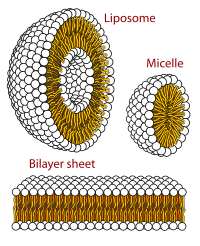
Photo from wikipedia
The properties of synthesized diblock poly(N-isopropylacrylamide)-poly((3-acrylamidopropyl)trimethylammonium chloride) and triblock methoxy-poly(ethylene glycol)-poly(N-isopropylacrylamide)-poly((3-acrylamidopropyl)trimethylammonium chloride) cationic copolymers at the silica/aqueous interface are investigated using quartz crystal microbalance with dissipation monitoring (QCM-D) and atomic… Click to show full abstract
The properties of synthesized diblock poly(N-isopropylacrylamide)-poly((3-acrylamidopropyl)trimethylammonium chloride) and triblock methoxy-poly(ethylene glycol)-poly(N-isopropylacrylamide)-poly((3-acrylamidopropyl)trimethylammonium chloride) cationic copolymers at the silica/aqueous interface are investigated using quartz crystal microbalance with dissipation monitoring (QCM-D) and atomic force microscopy (AFM). Moreover, dynamic light scattering is employed to assess the copolymers in terms of the hydrodynamic size and interchain aggregation. Although viscoelastic Voigt modeling of the QCM-D data suggests a comparable layer thickness for the copolymers on the silica surface, the AFM imaging and colloidal probe measurements reveal significant differences in surface coverage and thickness of the layers, which are discussed and compared with respect to the stabilization effect by the hydrophilic poly(ethylene glycol) block.
Journal Title: Journal of colloid and interface science
Year Published: 2017
Link to full text (if available)
Share on Social Media: Sign Up to like & get
recommendations!